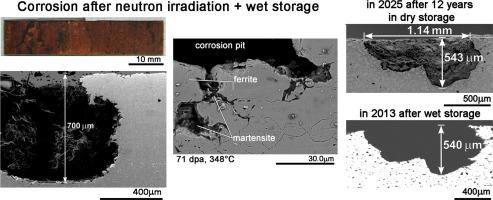EP-450铁素体-马氏体钢中子辐照及乏燃料池长期贮存后的腐蚀
IF 3.2
2区 工程技术
Q3 MATERIALS SCIENCE, MULTIDISCIPLINARY
引用次数: 0
摘要
高级铁素体-马氏体(F/M)钢由于具有优异的抗膨胀、高温脆化和辐射蠕变性能,常用于钠冷快堆(SFRs)。然而,F/M钢的一个潜在弱点在于它们在充满水的乏燃料池中长时间储存的耐腐蚀性较低。这带来了巨大的挑战,特别是在燃料储存和反应堆退役期间,增加了放射性污染的风险、安全隐患和大量的财务成本。在这里,我们展示并解释了EP-450铁素体马氏体钢(1Cr13Mo2NbBV)在BN-350 SFR中高达70 dpa的辐照和随后在反应堆乏燃料池中长期(50°C下20年)湿储存后的显著腐蚀敏感性。腐蚀形态从氧化膜到各种形式的局部降解,包括非常深的点蚀、相选择腐蚀、晶内腐蚀和相间腐蚀。深坑是通过相边界的优先溶解和回火马氏体相形成的,导致未受影响的铁素体晶粒最终脱离。铁素体和奥氏体钢中不存在回火马氏体相,而回火马氏体相的存在和优先溶解是EP-450钢发生严重局部腐蚀损伤的主要原因。本文章由计算机程序翻译,如有差异,请以英文原文为准。

Corrosion of EP-450 ferritic-martensitic steel after neutron irradiation and long-term storage in spent fuel pool
Advanced ferritic-martensitic (F/M) steels are often used in sodium-cooled fast nuclear reactors (SFRs), given their superior resistance to swelling, high-temperature embrittlement, and radiation creep. However, a potential vulnerability of F/M steels lies in their low corrosion resistance to prolonged storage in water-filled spent fuel pools. This poses a significant challenge, especially during fuel storage and reactor decommissioning, increasing the risk of radioactive contamination, safety hazards, and substantial financial costs. Here we show and explain significant corrosion susceptibility of EP-450 ferritic-martensitic steel (1Cr13Mo2NbBV) after irradiation in the BN-350 SFR up to 70 dpa and subsequent long-term (20 years at <50 °C) wet storage in the reactor's spent fuel pool. Corrosion morphologies ranged from oxide films to various forms of localized degradation, including very deep pitting, phase-selective attack, intragranular attack, and interphase corrosion. Deep pits mechanistically form via the preferential dissolution of phase boundaries and the tempered martensitic phase, leading to the eventual detachment of unaffected ferrite grains. The presence and preferential dissolution of the tempered martensitic phase, which is absent in ferritic or austenitic steels, is the dominant factor driving this severe localized corrosion damage in EP-450 steel.
求助全文
通过发布文献求助,成功后即可免费获取论文全文。
去求助
来源期刊

Journal of Nuclear Materials
工程技术-材料科学:综合
CiteScore
5.70
自引率
25.80%
发文量
601
审稿时长
63 days
期刊介绍:
The Journal of Nuclear Materials publishes high quality papers in materials research for nuclear applications, primarily fission reactors, fusion reactors, and similar environments including radiation areas of charged particle accelerators. Both original research and critical review papers covering experimental, theoretical, and computational aspects of either fundamental or applied nature are welcome.
The breadth of the field is such that a wide range of processes and properties in the field of materials science and engineering is of interest to the readership, spanning atom-scale processes, microstructures, thermodynamics, mechanical properties, physical properties, and corrosion, for example.
Topics covered by JNM
Fission reactor materials, including fuels, cladding, core structures, pressure vessels, coolant interactions with materials, moderator and control components, fission product behavior.
Materials aspects of the entire fuel cycle.
Materials aspects of the actinides and their compounds.
Performance of nuclear waste materials; materials aspects of the immobilization of wastes.
Fusion reactor materials, including first walls, blankets, insulators and magnets.
Neutron and charged particle radiation effects in materials, including defects, transmutations, microstructures, phase changes and macroscopic properties.
Interaction of plasmas, ion beams, electron beams and electromagnetic radiation with materials relevant to nuclear systems.
 求助内容:
求助内容: 应助结果提醒方式:
应助结果提醒方式:


